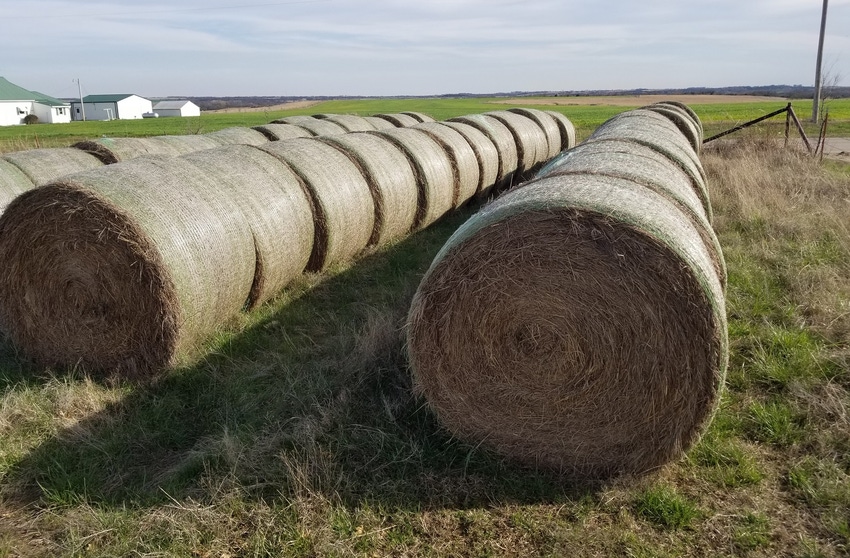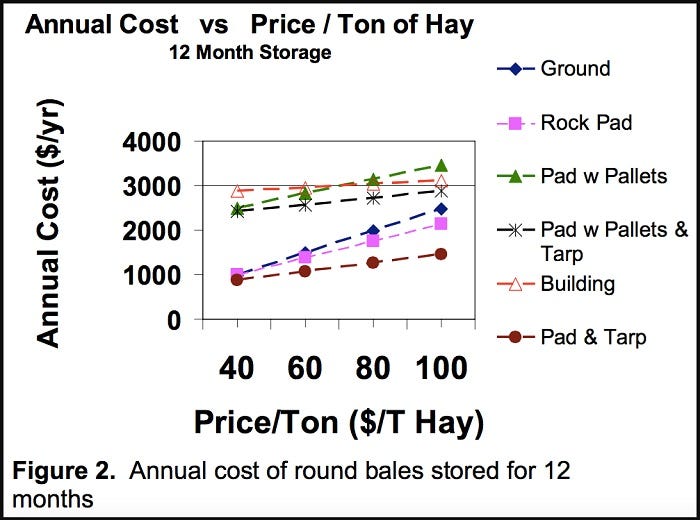
Hay is expensive, so if you use a lot of hay, getting the most from what you have makes a lot of sense.
In wet winters like the last two, it can be vital just for getting through until spring. Doing that has two fundamental parts: storage and feeding.
Storage losses/savings
Hay spoilage is one of the first things to consider, and it can be viewed as somewhat of an equation.
Assuming bales are of the same forage material and wrapped or netted consistently, you are balancing length of time of exposure and the amount of moisture against spoilage. The more time and moisture, the more spoilage. Less time and moisture generally equates to less spoilage.
Here are some interesting facts from hay storage research:
Wisconsin data says hay stored outside and/or in moist climates typically loses 1-3% dry matter per month. Hay stored inside and/or in dry climates typically drops 0.5-1.5% dry matter per month.
Round bales of sorghum-sudan hay stored in Walker County in eastern Texas can lose up to 50% in a year.
Research at the Overton, Texas, showed weathered hay in stored round bales lost 14% of its protein. Weather damage on the outside of bales decreased the energy content of the hay from 46% to 14.9% TDN.
In all Texas demonstrations, hay stored in a barn or protected from the weather increased feed utilization from 65% to 92.9% when compared with hay stored outside.
Of course, hay barns and other storage improvements cost money, so the trick is to figure out whether those costs can be recouped by decreasing hay spoilage.
Using an example of about 380 round bales in Wisconsin, Brian Holmes an extension specialist for the University of Wisconsin, found the lowest-cost alternative in both 6- and 12-month storage systems was the use of a crushed rock pad with a tarp covering. He wrote an Excel spreadsheet program you can download and use to analyze your own hay-storage situation and options. Go to https://fyi.extension.wisc.edu/forage/dry-round-hay-bale-storage-costs/.
Feeding losses/savings
Hay waste during feeding is another variable you can affect, and it varies with the way in which hay is fed. University of Missouri researchers estimated feeding a one-day supply of small square bales with a rack would create loss of just under 4%, versus a loss of 6.7% for a one-day without racks
Large round or square bales fed in a rack and one day at a time create loss of about 5%, or about 5.5% when fed in a rack with seven days’ supply.
However, when these large bales are fed without racks the cattle tend to waste about 12% of the hay if given one days’ supply, or 40% or more if given seven days of supply.
The type of hay feeder seems to matter, as well. Cone-type feeders have shown they produce the least waste in several trials. In Wisconsin several years ago, dry-matter hay waste was 3.5% for cone feeders, 6.1% for ring feeders, 11.4% for trailer feeders and 14.6% cradle feeders.
At the Dickinson Research Center in North Dakota State University researchers found cows fed by rolling out bales on the ground gained less than cows fed with either a bale processor or tapered-cone feeder. They also said feeding costs per cow in the 100-head analysis for were $113.90 for rolling out bales, $128.10 for shredding bales with a processor and $101.80 for feeding bales in a tapered-cone feeder.
A hybrid solution
The Forage Systems Research Center in Missouri has developed a low-labor but efficient system for feeding large round bales using moveable electric fence and hay rings.
In this system, the bales are grouped in a corner of the pasture before winter feeding time (often at harvest). This reduces labor, tractor use, and pasture damage from running trucks or tractors during muddy conditions. The hay rings decrease hay waste significantly as part of this system.
Bales are spaced on 20-foot centers. The number of bales per paddock is based on bale size, herd size and planned length of stay. Using the example of a 30-cow herd, you would need one 900-pound bale per day. Therefore, placing 10 bales in a paddock would supply about ten days' worth of feed for a 30-cow herd, five days of feed for a 60-cow herd, and so forth.
The bale storage area is blocked off with electric fencing. When the hay is needed, the fence is moved and rings are placed around a two- or three-day supply of hay. This should allow all cattle access to ample feed, minimize waste and still allow for the distribution of manure over several paddocks. One big advantage of this system is that a three-day supply of hay for 50 cows can be fed in about 15 minutes. This system should work especially well with management-intensive grazing systems where bales are stored in several paddocks and cows are well-trained to electric fence. Read more about it at: https://extension2.missouri.edu/g4570

About the Author(s)
You May Also Like




